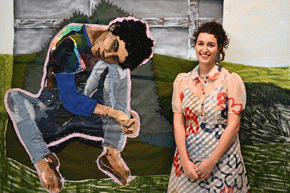Going abroad
J-Wire’s music reviewer Fraser Beath McEwing has added another string to his bow as he takes J-Wire readers on his travels..he visits Russia’s Versailles.
Another St Petersburg must-see if you want to avoid travellers’ ridicule is the summer palace of Peter the Great, or Peterhof. It has been called the Russian Versailles – although it didn’t look too good in 1944 when the departing Germans blew it up, but restoration work began almost immediately and today it looks to be back in pristine condition.
To get there we boarded a 1980s so-called hydrofoil which looked like a wingless, aircraft fuselage. It sits low in the water, promising to get up on its foils and skim when the smelly, shuddering engine fires up. But it doesn’t, because once the speed passes a certain point the nose sticks up and the passengers (mostly Chinese) can’t see. To prevent a mutiny, it ploughs through the Gulf of Finland chop like a grumbling old man until it arrives at the Peterhof wharf.
Immediately you understand Peter’s reception plan. Guests would arrive by ship, then small boats would ferry them up a canal and deposit them at the base of the palace where they would be humbled by the spectacle of the buildings, grand cascade, exotic fountains and gleaming gold baroque statues.

Visitors arrived here from the Gulf of Finland to be greeted by Peter the Great
There are some 150 fountains and spectacular cascades throughout the 100 hectares of ordered gardens, but pump technology was not nearly developed enough to drive them. There was a much cleverer solution. 20 kilometres away, an elevated lake system piped water, in ever diminishing sized pipes, down the hillside. By the time it reached Peterhof it had picked up the enormous pressure required to drive all the water features of the palace. Moreover, because there was plenty of water in the lakes, the fountains could run all summer without a break.
Oddly, we hadn’t come to see the palace, except from the outside. The big attractions were the gardens, the fountains, and the bathhouse that adjoins the palace. The bathhouse building also housed the palace kitchen to cut down the risk of a spreading fire if the dripping caught alight.
In the bathhouse, the banya (Russia sauna), used cannonballs to store the needful heat. In winter you could hot up and then go outside for a jolly roll in the snow. Before Peter’s time it was customary for men and women to be in the banya together but eventually they had to be segregated because there was excessive canoodling which to led to giving one another doses of the Clap.
A lady could take a shower (cold, unfortunately) by going down some steps into a sunken, open-top room, sitting on a stool and being pelted by an ornamental shower rose that hung from the ceiling.

Another way to have water fun was in a hexagonal swimming pool with a central shower ball on a pole in the middle and, for good measure, a number of geysers that came up through holes in wooden floor. And then, of course, there was the common marble bath – often covered with cloth to save one’s flanks coming into contact with the cold stone.

Russians believe in subtle, understated signage
We finished the day with ‘dinner and a show’ at the Belmond Hotel which, we have now been told by our guides, is arguably the best in St Petersburg, and certainly the best located, sitting in the middle of the concert and designer district. The grand dining room had been cleared so that only 16 tables covered the whole area and the stage had been extended to accommodate a loud pianist, string quartet, two singers and two dancers. They gave a classical program of second-eleven standard while waiters speedily crisscrossed in the style of the Ministry of Silly Walks. The food, however, was exceptional. We both had beef cheeks – avoiding the menu page which offered Beluga caviar at about $520 for 100 grams. But I have to say it was a classical experience, especially knowing that Tchaikovsky had stayed in the hotel, first in 1877 with his wife (who we know didn’t do much for him in the sack) and nine years later returned, only bump into Johann Strauss.







